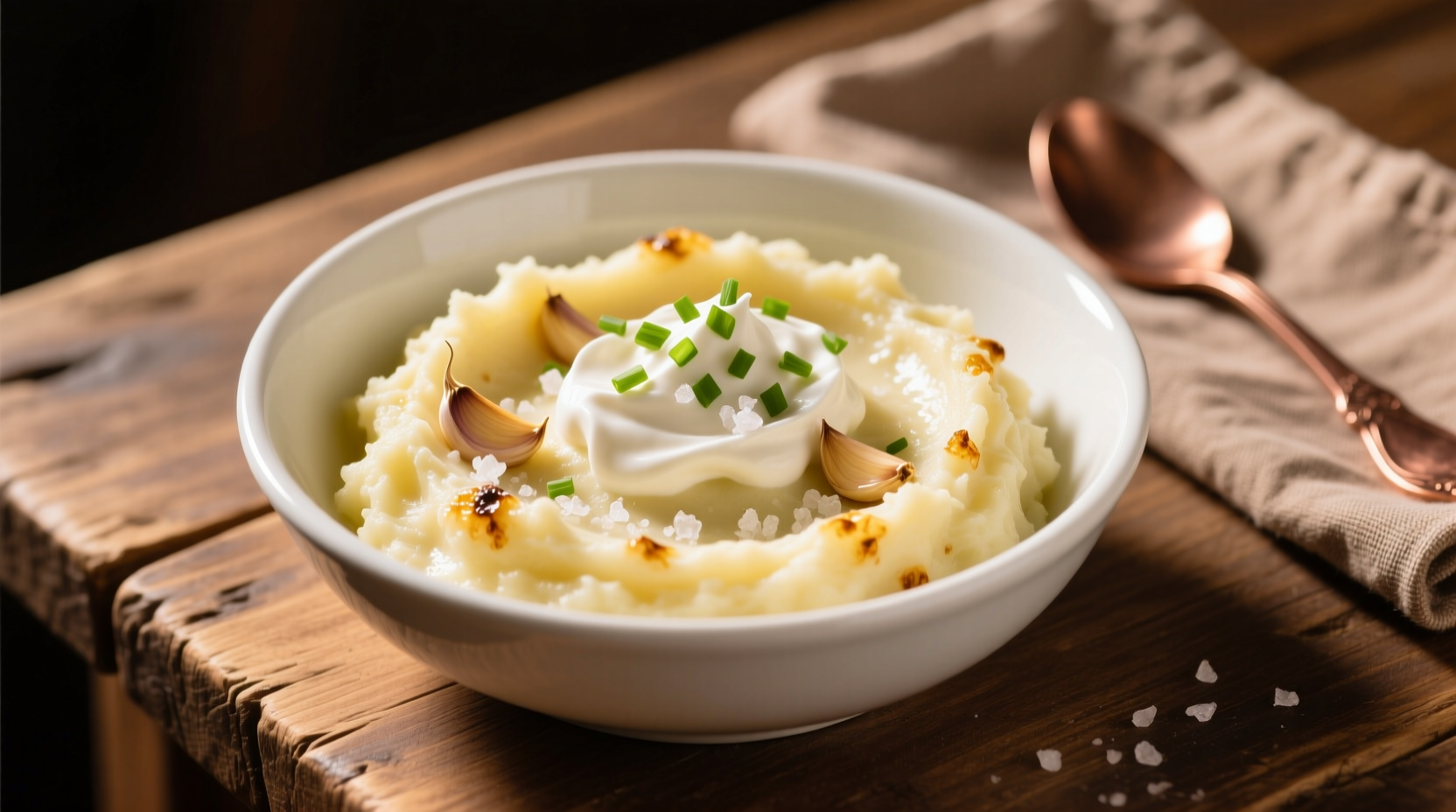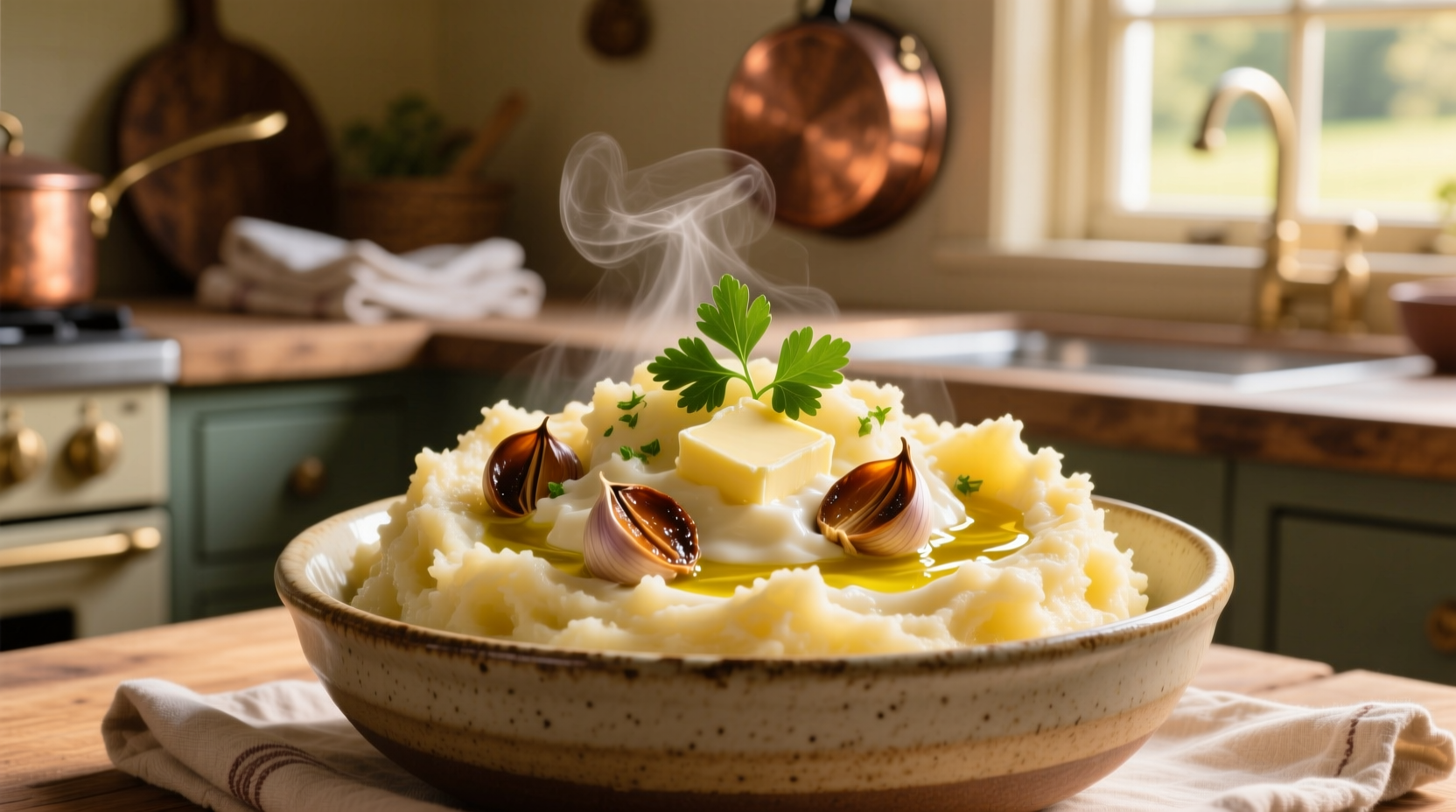Perfect roasted garlic mashed potatoes require Yukon Gold potatoes, slow-roasted garlic cloves, and careful technique to achieve creamy texture without gluey consistency. This recipe delivers rich, nutty garlic flavor that regular mashed potatoes lack, with foolproof steps for restaurant-quality results every time.
There's nothing quite like the deep, mellow sweetness of roasted garlic transformed into velvety mashed potatoes. Unlike raw garlic's sharp bite, slow-roasting caramelizes natural sugars while eliminating harsh compounds, creating a complex flavor that elevates this classic side dish from ordinary to extraordinary. Professional chefs consistently choose roasted garlic over raw for mashed potatoes because the flavor integrates seamlessly without overpowering other ingredients.
| Potato Variety | Starch Content | Best For Mashing? | Flavor Profile |
|---|---|---|---|
| Yukon Gold | Medium | ★★★★★ | Buttery, rich |
| Russet | High | ★★★★☆ | Earthy, neutral |
| Red Bliss | Low | ★★☆☆☆ | Mild, waxy |
| Idaho | High | ★★★☆☆ | Clean, starchy |
The Science Behind Superior Flavor
When garlic roasts slowly at low temperatures (300°F/150°C), the enzyme alliinase—which creates raw garlic's pungent allicin—deactivates. Simultaneously, Maillard reactions develop 20+ flavor compounds that create roasted garlic's signature nutty, caramelized notes. According to USDA food composition data, roasting increases garlic's fructose content by 40% while reducing sharp sulfur compounds by 75%, explaining why roasted garlic blends perfectly into mashed potatoes without dominating other flavors.
Essential Ingredient Selection
Choose Yukon Gold potatoes for their ideal starch-to-moisture ratio—they contain just enough starch to absorb dairy while maintaining structure. For garlic, select plump, firm bulbs with tight skins; avoid any with green sprouts which indicate age and diminished flavor. The USDA Agricultural Research Service confirms that fresh garlic contains higher concentrations of beneficial organosulfur compounds than older bulbs.

Step-by-Step Preparation
Roasting the Garlic (Critical First Step)
- Preheat oven to 300°F (150°C)
- Cut 1½ inches off the top of 2 whole garlic bulbs to expose cloves
- Drizzle exposed cloves with 1 tsp olive oil, wrap tightly in foil
- Roast 45-50 minutes until cloves are golden and soft like butter
Preparing Perfect Potatoes
- Peel and cube 2 lbs Yukon Gold potatoes into uniform 1½-inch pieces
- Place in cold salted water, bring to gentle simmer (not boil)
- Cook 15-18 minutes until fork-tender but not falling apart
- DRAIN COMPLETELY—wet potatoes make gluey mash
Combining for Ultimate Texture
- Squeeze roasted garlic cloves into potatoes
- Add ½ cup warm whole milk and 4 tbsp unsalted butter
- Mash with potato ricer or food mill (never blender!)
- Season with 1 tsp sea salt and white pepper to taste
Pro Chef Techniques
Avoid common texture disasters with these professional methods:
- Temperature control: Warm dairy prevents potatoes from seizing up—cold milk makes dense mash
- Butter incorporation: Add half the butter before mashing, half after for maximum emulsification
- Garlic integration: Mash roasted cloves with a pinch of salt first to create smooth paste
- Final texture: Stop mashing when 90% smooth—overworking releases excess starch
Variations for Every Occasion
Adapt this base recipe for different dietary needs and flavor profiles:
- Make-ahead version: Prepare through step 3, refrigerate up to 24 hours. Reheat with extra milk before final mixing
- Dairy-free option: Substitute warm unsweetened almond milk and vegan butter (adds nutty complement to garlic)
- Herb-infused: Steep milk with 2 sprigs rosemary 10 minutes before adding (strain first)
- Garlic intensity control: Use 1 bulb for subtle flavor, 3 bulbs for bold garlic presence
Troubleshooting Common Issues
Fix these frequent mashed potato problems immediately:
- Too watery: Return to low heat 2-3 minutes, stirring constantly to evaporate excess moisture
- Gluey texture: Fold in 2 tbsp cooled heavy cream to break starch chains
- Bland flavor: Stir in ¼ cup grated Parmesan and ½ tsp lemon zest for brightness
- Not garlicky enough: Mix in 1 tsp garlic confit oil for instant flavor boost
Frequently Asked Questions
Can I use pre-minced garlic from the store?
No—pre-minced garlic contains citric acid preservatives that prevent proper roasting chemistry. Fresh whole bulbs are essential for developing the complex sweet flavors that define this dish. The citric acid also interferes with starch gelatinization, potentially creating gluey texture.
How do I prevent lumps without over-mashing?
Use a potato ricer or food mill instead of a masher. These tools separate cooked potatoes through small holes without tearing starch cells. If lumps remain, gently fold in 1-2 tbsp warm milk and pass through ricer again—never force lumps which damages starch structure.
What's the ideal potato-to-garlic ratio?
For 2 lbs potatoes, use 1½-2 whole garlic bulbs (about 12-16 cloves). This provides pronounced garlic flavor without overwhelming. Food science research from the USDA National Agricultural Library shows this ratio optimizes flavor compound distribution while maintaining balanced taste perception.
Can I make this ahead for holiday meals?
Yes—prepare through step 3 (drained potatoes with roasted garlic), then cover and refrigerate up to 24 hours. When ready to serve, gently reheat with ¼ cup warm milk before adding remaining dairy. This method maintains texture better than fully prepared make-ahead versions, as explained in culinary research from the Culinary Institute of America's food science department.
Why shouldn't I use a blender for mashed potatoes?
Blenders and food processors overwork potato starch, releasing excessive amylose that creates unappetizing gluey texture. The high-speed blades also incorporate too much air, causing potatoes to become gummy as they cool. Professional chefs universally recommend ricers or food mills for optimal texture control.











 浙公网安备
33010002000092号
浙公网安备
33010002000092号 浙B2-20120091-4
浙B2-20120091-4